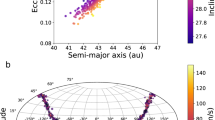Abstract
Asteroid families are groups of small bodies that share certain orbit1 and spectral properties2. More than 20 families have now been identified, each believed to have resulted from the collisional break-up of a large parent body3 in a regime where gravity controls the outcome of the collision more than the material strength of the rock. The size and velocity distributions of the family members provide important constraints for testing our understanding of the break-up process, but erosion and dynamical diffusion of the orbits over time can erase the original signature of the collision4,5. The recently identified young Karin family6 provides a unique opportunity to study a collisional outcome almost unaffected by orbit evolution. Here we report numerical simulations modelling classes of collisions that reproduce the main characteristics of the Karin family. The sensitivity of the outcome of the collision to the internal structure of the parent body allows us to show that the family must have originated from the break-up of a pre-fragmented parent body, and that all large family members formed by the gravitational reaccumulation of smaller bodies. We argue that most of the identified asteroid families are likely to have had a similar history.
This is a preview of subscription content, access via your institution
Access options
Subscribe to this journal
Receive 51 print issues and online access
$199.00 per year
only $3.90 per issue
Buy this article
- Purchase on Springer Link
- Instant access to full article PDF
Prices may be subject to local taxes which are calculated during checkout


Similar content being viewed by others
References
Milani, A. & Knezěvić, Z. Asteroid proper elements and the dynamical structure of the asteroid main belt. Icarus 107, 219–254 (1994)
Zappalà, V., Bendjoya, P., Cellino, A., Farinella, P. & Froeschlé, C. Asteroid families: Search of a 12,487-asteroid sample using two different clustering techniques. Icarus 116, 291–314 (1995)
Farinella, P., Davis, D. R. & Marzari, F. in Completing the Inventory of the Solar System (eds Rettig, T. W. & Hahn, J. M.) 45–55 (ASP Conference Series 107, Astronomical Society of the Pacific, San Francisco, 1996)
Marzari, F., Farinella, P. & Davis, D. R. Origin, aging, and death of asteroid families. Icarus 142, 63–77 (1999)
Bottke, W. F., Vokrouhlický, D., Brož, M., Nesvorný, D. & Morbidelli, A. Dynamical spreading of asteroid families via the Yarkovsky effect. Science 294, 1693–1696 (2001)
Nesvorný, D., Bottke, W. F., Dones, L. & Levison, H. F. The recent breakup of an asteroid in the main-belt region. Nature 417, 720–722 (2002)
Michel, P., Benz, W., Tanga, P. & Richardson, D. C. Collisions and gravitational reaccumulation: Forming asteroid families and satellites. Science 294, 1696–1700 (2001)
Michel, P., Benz, W., Tanga, P. & Richardson, D. C. Formation of asteroid families by catastrophic disruption: Simulations with fragmentation and gravitational reaccumulation. Icarus 160, 10–23 (2002)
Melosh, J. G. & Ryan, E. V. Asteroids: shattered but not dispersed. Icarus 129, 562–564 (1997)
Tillotson, J. H. Metallic Equations of State for Hypervelocity Impact (General Atomic Report GA-3216, San Diego, 1962)
Thompson, S. L. & Lauson, H. F. Improvement in the chart D radiation hydrodynamic code III: revised analytic equation of state. (Report SC-RR-71 0714, Sandia National Laboratory, Albuquerque, 1972).
Belton, B. et al. The bulk density of asteroid 243 Ida from Dactyl's orbit. Nature 374, 785–788 (1995)
Yeomans, D. K. et al. Radio science results during the NEAR-Shoemaker spacecraft rendezvous with Eros. Science 289, 2085–2088 (2000)
Flynn, G. J., Moore, L. B. & Klø¨ck, W. Density and porosity of stone meteorites: implications for the density, porosity, cratering, and collisional disruption of asteroids. Icarus 142, 97–105 (1999)
Bottke, W. F., Nolan, M. C., Greenberg, R. & Kolvoord, R. A. Velocity distributions among colliding asteroids. Icarus 107, 255–268 (1994)
Benz, W. & Asphaug, E. Catastrophic disruptions revisited. Icarus 142, 5–20 (1999)
Richardson, D. C., Quinn, T., Stadel, J. & Lake, G. Direct large-scale N-body simulations of planetesimal dynamics. Icarus 143, 45–59 (2000)
Asphaug, E. et al. Disruption of kilometre-sized asteroids by energetic collisions. Nature 393, 437–440 (1998)
Acknowledgements
P.M. acknowledges financial support from the Action Thématique Innovante 2001 of the French INSU, the programme ‘Bonus-Qualité-Recherches 2001’ and the Cassini laboratory of the Côte d'Azur Observatory (OCA). W.B. and D.C.R. acknowledge support respectively from the Swiss National Science Foundation and NASA through the Office of Space Science. Simulations were carried out on 4-processor Compaq DEC Alpha workstations thanks to the SIVAM project and the ILGA team of the OCA and on a Beowulf installed by the society Alineos.
Author information
Authors and Affiliations
Corresponding author
Ethics declarations
Competing interests
The authors declare that they have no competing financial interests.
Rights and permissions
About this article
Cite this article
Michel, P., Benz, W. & Richardson, D. Disruption of fragmented parent bodies as the origin of asteroid families. Nature 421, 608–611 (2003). https://doi.org/10.1038/nature01364
Received:
Accepted:
Issue Date:
DOI: https://doi.org/10.1038/nature01364
This article is cited by
-
Second harmonic generation of femtosecond laser pulses of central wavelength 1000 nm, 1100 nm and 1300 nm using ZnO nanorods
Optical and Quantum Electronics (2023)
-
Dust Phenomena Relating to Airless Bodies
Space Science Reviews (2018)
-
Impact process of boulders on the surface of asteroid 25143 Itokawa—fragments from collisional disruption
Earth, Planets and Space (2008)
Comments
By submitting a comment you agree to abide by our Terms and Community Guidelines. If you find something abusive or that does not comply with our terms or guidelines please flag it as inappropriate.



